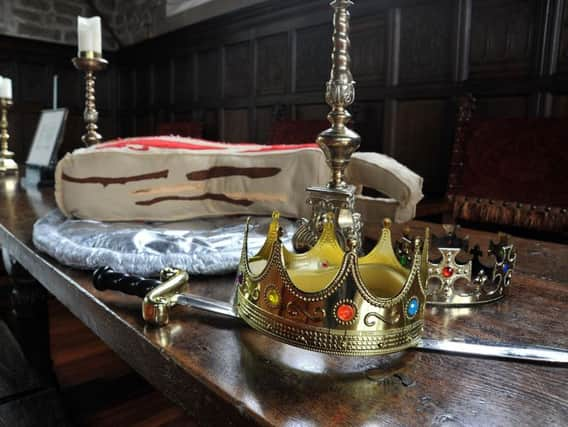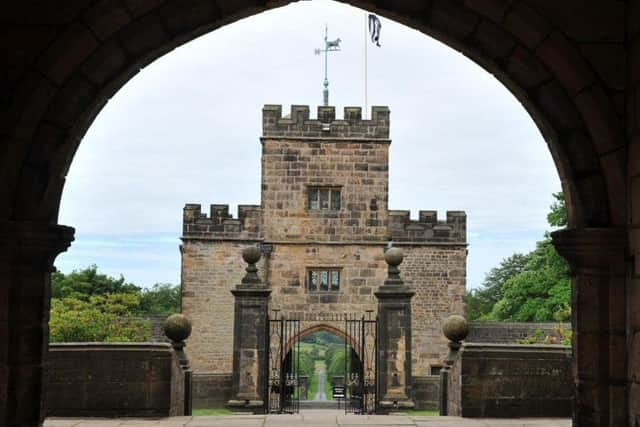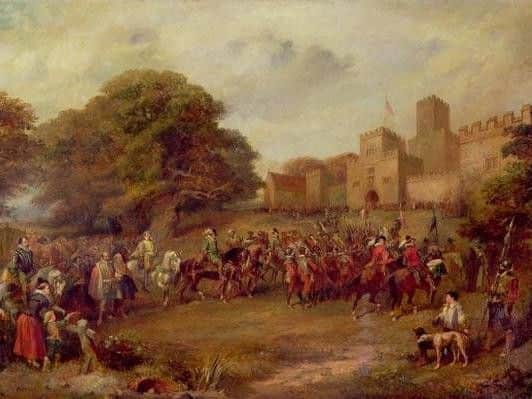When a king knighted a piece of beef


Between August 15 and 17, 1617, King James I made his extravagant entrance to Hoghton Tower on half a mile of velvet at the tower entrance.
Hoghton Tower is the location where the royal visitor tasted a joint of beef so good that he famously knighted it; from then on, the beef loin “henceforth... shall be SIR-LOIN”.
Advertisement
Hide AdAdvertisement
Hide AdThe grandiose weekend and the ‘Sir-loin’ story attached to the weekend brings hundreds of visitors to the tower each year, where they are educated on the visit of King James I and how the famous knighting of the joint of meat came about.


It was a three-day royal visit to Richard Hoghton’s tower, a stop on King James’ journey to Scotland.
According to the documentation of noted Lancashire diarist of the time Nicholas Assheton, the banquet was huge and the court ate a variety of pastries, meats, and “inumerable other good things”.
Cooking at this event was seen as a masculine job, so the many dishes were only prepared by male hands and women were expected only to wait on the tables and serve the food.
Advertisement
Hide AdAdvertisement
Hide AdThe weekend was extravagant and, as expected, extremely expensive.


The food drink and entertainment put on to entertain the king and guests was so pricy that it almost bankrupted the Hoghton family.
Although he gained mining rights from the King’s royal visit, it was not enough to pay off his debt and as a result Richard Hoghton was sent to Fleet Prison in order to pay off his debts.
Despite his jail sentence, the greatness of the day goes down in history.
Advertisement
Hide AdAdvertisement
Hide AdIt was an event held with hundreds of the wealthiest families in Lancashire, with plays, hunting and a great feast.


It was at this banquet that the knighting of the sirloin took place, which began as a joke but has now been immortalised and exactly 400 years later it is still the term used for our sirloin steak.
A large part of the festivities included hunting wild boar in the Holcombe hunt, a British tradition which dates back to 1086 and is continued to this day.
In 1617, this hunt took place on Sunday after mass and worship was an event significant enough to be captured in George Cattermole’s oil painting ‘Visit of King James I to Hoghton Tower in 1617’.
Advertisement
Hide AdAdvertisement
Hide AdIn the painting, the hunt can be see on horseback and King James allowed the members to wear scarlet livery embroided with gold which was a great honour at the time as the livery colours represented wealth and royalty.


The novelty of the knighting of the loin and the hunt often overshadows other events that took place on this day.
This is also the day that King James presented ‘The Book of Sports’, a declaration that he would introduce to everyone at the banquet.
This is a book which attempts to provide a solution to the argument over which physical activities are acceptable on holy days.
Advertisement
Hide AdAdvertisement
Hide AdThe text highlights how, “leaping, vaulting, or any other such harmless recreation” are acceptable on holy days, but only after one had been to mass.
This was a book which attempted to quell religious disagreements between the Puritans and Catholics in Lancashire.
King James’ famous sirloin story, and the beautiful gardens, have made the tower a key destination of culture in Lancashire.
The Grade I listed building has been preserved so future generations may visit and learn about the history of the tower.
Advertisement
Hide AdAdvertisement
Hide AdIt is well known for its castle grounds and the wilderness garden which holds greenery and walls of aged oak trees.
As part of the tradition for visitors, Hoghton had guests plant a tree on the tower grounds that became commemorative of their stay.
Trees in the past have been planted by fellow figures from the history books, including Lady Godiva, George V and the Duke of Edinburgh.
It is claimed other rich noblemen in Lancashire burned their homes down so they could not be selected to house the King as it was cheaper to buy a new house than to pay the debt of a weekend hosting the King.
Advertisement
Hide AdAdvertisement
Hide AdIt was a weekend that Richard Hoghton paid for in prison, nevertheless it is still a weekend that is cemented in history.
It is an event that is celebrated and remembered 400 years on and for good reason.
It was a weekend of reformations surrounding the law of activities on holy day that for so long had caused tension between the puritans and the catholics.
But will the history of King James I and his visit to Hoghton Tower is still talked of 400 years from now? Time will tell.